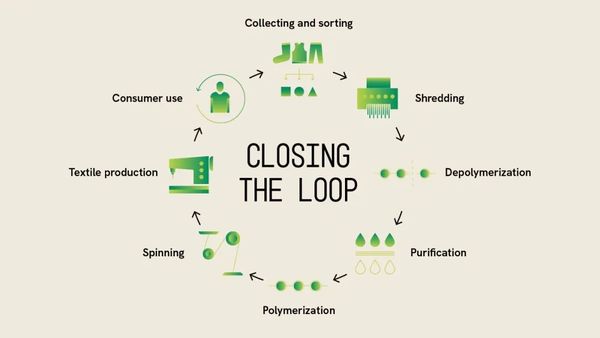Global first! BASF's recycled nylon project has been put into production.
On March 27, BASF announced the official launch of the world's first commercial loopamid® production facility at its Caojing base in Shanghai. With an annual production capacity of 500 tons, this project marks a significant milestone in the development of sustainable products for the textile industry.
loopamid® is a regenerated polyamide 6 completely based on industrial and post-consumer waste textiles, with raw materials including production waste such as clothing scraps from the textile industry, and even discarded old clothing made from polyamide 6 and other materials. loopamid® products have all been certified by the Global Recycled Standard (GRS), and the first batch of yarn manufacturers has successfully used them. (In 2024, BASF collaborated with Inditex to launch the first nylon 6 jacket made entirely from 100% textile waste.)
In fact, last November, BASF's Monomers division announced that its polyamide 6 production facility in Shanghai had received the International Sustainability and Carbon Certification (ISCC+), enabling the supply of bio-based Ultramid® BMB Cert™ polyamide 6 and Ccycled® polyamide 6, as well as polyamide 6/6.6 copolymer products. Among these, Ultramid® Ccycled® polyamide 6 is produced using pyrolysis oil extracted from end-of-life tires and mixed plastic waste through chemical recycling.
Researching recycled polyamide 6 is very necessary, especially considering that the production capacity in the Chinese market will reach 7.25 million tons per year in 2024, and the industry continues to expand. By 2028, it is expected to reach 9.28 million tons per year! BASF has launched two types of recycled polyamide 6, both of which are chemically recycled, but the raw materials and processes are different. The loopamid® product is particularly significant, as fibers are its largest application scenario and source of waste.
The loopamid® production process includes collection and sorting, shredding, depolymerization into monomers, purification, polymerization, spinning, and finished products. A major challenge is that the raw materials are typically made from different fibers, materials, dyes, and additives, and buttons, zippers, and other accessories must be removed in advance. BASF has successfully made it possible to achieve closed-loop recycling of polyamide 6 textiles, including blends containing elastane.

Source: BASF official website
Depolymerization is the core, with common methods including hydrolysis, ammonolysis, alcoholysis, ionic liquids, and enzymatic degradation. BASF previously reported the use of acids (such as phosphoric acid, phosphorous acid) or bases (such as alkali metal hydroxides, alkali metal oxides) to depolymerize waste PA6, achieving the recycling of used PA6 carpets. In 2023, BASF and Inditex jointly launched the first nylon 6 jacket made entirely from 100% textile waste.
DuPont primarily uses the ammonolysis method to recover mixed waste of PA6 and PA66. In September 2023, Toray reported collaborating with Honda to validate supercritical hydrolysis depolymerization technology for chemically recycling glass fiber-reinforced nylon 6 components recovered from end-of-life vehicles, claiming that it takes only tens of minutes to depolymerize waste nylon 6 into caprolactam monomers.
In addition, on December 9 of last year, Australian Samsara Eco, which had previously been invested in by Temasek, Lululemon, Hitachi, Coca-Cola, and others, announced that it had developed an enzyme capable of recycling nylon 6 using machine learning algorithms. This enzyme can break down nylon 6 from clothing, knitwear, and automotive materials into its original building blocks, and even with repeated use, the quality does not deteriorate; it can almost be said to enable infinite recycling. On February 20 of this year, Lululemon collaborated with Samsara Eco to launch the world's first enzyme-recycled nylon 6,6 product.
In addition to Polyamide 6, BASF will also showcase a series of new polyurethane product solutions ("Loop") that incorporate recycled materials, tailored for the footwear, automotive, and synthetic leather industries. The technological breakthrough lies in the use of a series of precise and advanced liquefaction technologies during the sorting and shredding stages to recycle polyurethane products, transforming them into high-performance recycled materials that meet market standards and are commercially viable.
In addition to recycling and regenerating products, BASF is also actively developing biomass balance products (using renewable energy and renewable raw materials, non-food bio-based). Currently, it has launched products including polyamide, polyoxymethylene, polyurethane (including TPU and PU), polyether polyols, automotive coatings, as well as specific applications such as electrical safety components and synthetic leather.
Recently, BASF has also introduced a series of innovative products, including biomass-based melamine foam, polyethersulfone (PESU), and the world's first polyacrylate-based superabsorbent polymer (SAP) HySorb B6610 with a product carbon footprint (PCF) of zero.
Regardless of changes in international policies, BASF's sustainable strategy has always remained steadfast.
【Copyright and Disclaimer】The above information is collected and organized by PlastMatch. The copyright belongs to the original author. This article is reprinted for the purpose of providing more information, and it does not imply that PlastMatch endorses the views expressed in the article or guarantees its accuracy. If there are any errors in the source attribution or if your legitimate rights have been infringed, please contact us, and we will promptly correct or remove the content. If other media, websites, or individuals use the aforementioned content, they must clearly indicate the original source and origin of the work and assume legal responsibility on their own.
Most Popular
-

List Released! Mexico Announces 50% Tariff On 1,371 China Product Categories
-

Nissan Cuts Production of New Leaf EV in Half Due to Battery Shortage
-

New Breakthrough in Domestic Adiponitrile! Observing the Rise of China's Nylon Industry Chain from Tianchen Qixiang's Production
-

Dow, Wanhua, Huntsman Intensively Raise Prices! Who Controls the Global MDI Prices?
-

Mexico officially imposes tariffs on 1,400 chinese products, with rates up to 50%






